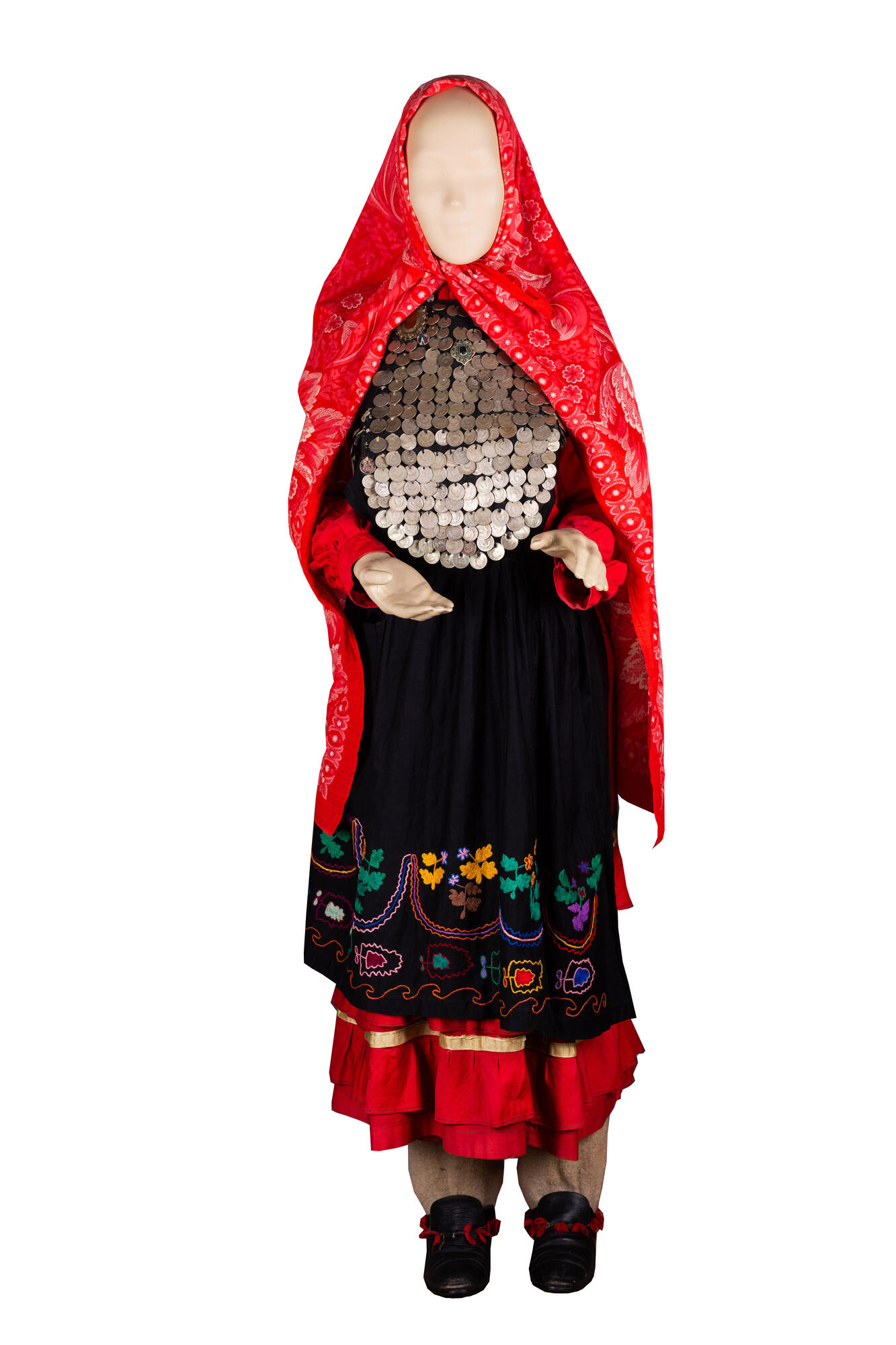The traditional costumes worn by Bashkir women have evolved over the centuries, and continue to change even today. The way it is decorated is distinguished by the variety of artistic design patterns, and wealth of different materials, that are used. The foundation of the traditional Bashkir women’s attire is a dress called a kuldek, which is decorated with embroidery with frilly hems. Frequently, an apron was worn on top of that. In the museum’s collection there is a black apron with a hem decorated with floral ornamentation: decorating the hems is a Bashkir tradition. Also, decorative strips could be sewn around the hems, and around the breast cut of the dress. In addition, the ends of the sleeves and collars were sometimes decorated, and the collar of the dress was often cut from fabric that provided contrasting color.
Over the neckline, Bashkir women wore bibs, called selters or yagas. The common folk believed that they warded off the influence of evil spirits. Depending on the region, the bibs could have different shapes: triangular or round, short or long. In the exposition at the Ethnography Hall there is a long, elegant bib, richly decorated with silver coins. Besides that kind of a bib, an embroidered, fitted camisole, called a yelyan, was often worn over the dress. That could be decorated with applique and braiding, and later decorative shoulder pads — epaulets — came into fashion. Stripes of green, red, and blue cloth imparted spectacular color designs to these clothes.
Generally speaking, decorations in abundance are what is typical of Bashkir attire. Usually, a tight pattern covered the skirt and sleeves of the dress, the hem and chest of the apron. Floral ornamentation consisting of fancifully curved branches with leaves and flowers was placed on dark black, dark blue, and purple sateen. Usually it was embroidered with a chain stitch: a chain of loops that were connected to each other. The sun and stars were also widespread ornamental motifs in the embroidery — they are often found on Bashkir robes. The sun was depicted as concentric circles with multi-colored rays, and a circle of colored cloth or a mother-of-pearl button was sewn in the middle. Sometimes, the sun was depicted using coral-colored threads.
On Bashkir clothing, ornamentation in the form of triangles and rhombuses was laid out using coral and coins. White and glass beads, mica sequins, multicolored tassels, shells, colored buttons, and even the mineral carnelian were also used in sewing for the purposes of ornamentation. Fringed bands were used to make patches in the area of the upper back and waist.
Over the neckline, Bashkir women wore bibs, called selters or yagas. The common folk believed that they warded off the influence of evil spirits. Depending on the region, the bibs could have different shapes: triangular or round, short or long. In the exposition at the Ethnography Hall there is a long, elegant bib, richly decorated with silver coins. Besides that kind of a bib, an embroidered, fitted camisole, called a yelyan, was often worn over the dress. That could be decorated with applique and braiding, and later decorative shoulder pads — epaulets — came into fashion. Stripes of green, red, and blue cloth imparted spectacular color designs to these clothes.
Generally speaking, decorations in abundance are what is typical of Bashkir attire. Usually, a tight pattern covered the skirt and sleeves of the dress, the hem and chest of the apron. Floral ornamentation consisting of fancifully curved branches with leaves and flowers was placed on dark black, dark blue, and purple sateen. Usually it was embroidered with a chain stitch: a chain of loops that were connected to each other. The sun and stars were also widespread ornamental motifs in the embroidery — they are often found on Bashkir robes. The sun was depicted as concentric circles with multi-colored rays, and a circle of colored cloth or a mother-of-pearl button was sewn in the middle. Sometimes, the sun was depicted using coral-colored threads.
On Bashkir clothing, ornamentation in the form of triangles and rhombuses was laid out using coral and coins. White and glass beads, mica sequins, multicolored tassels, shells, colored buttons, and even the mineral carnelian were also used in sewing for the purposes of ornamentation. Fringed bands were used to make patches in the area of the upper back and waist.


